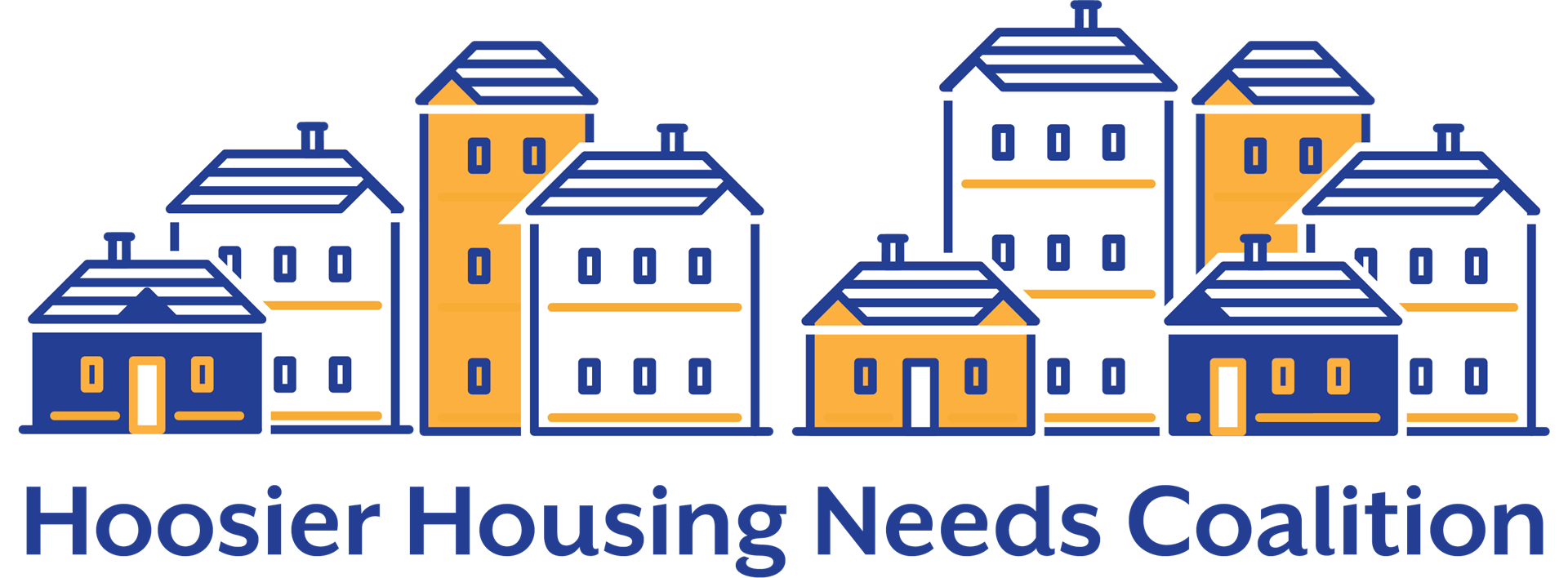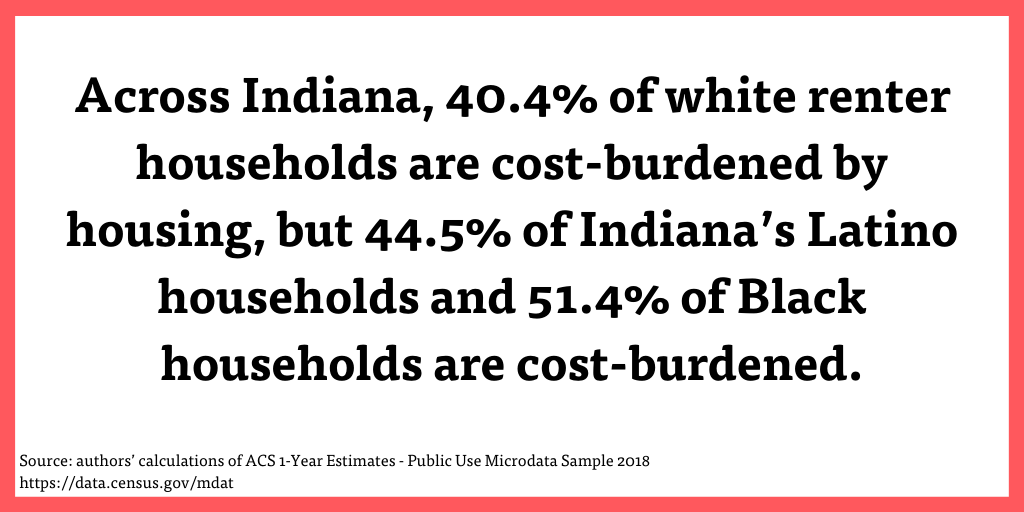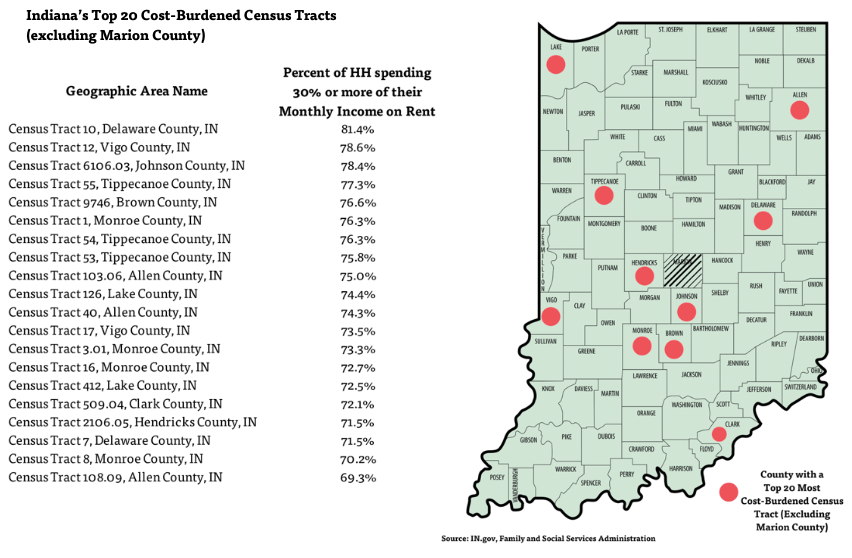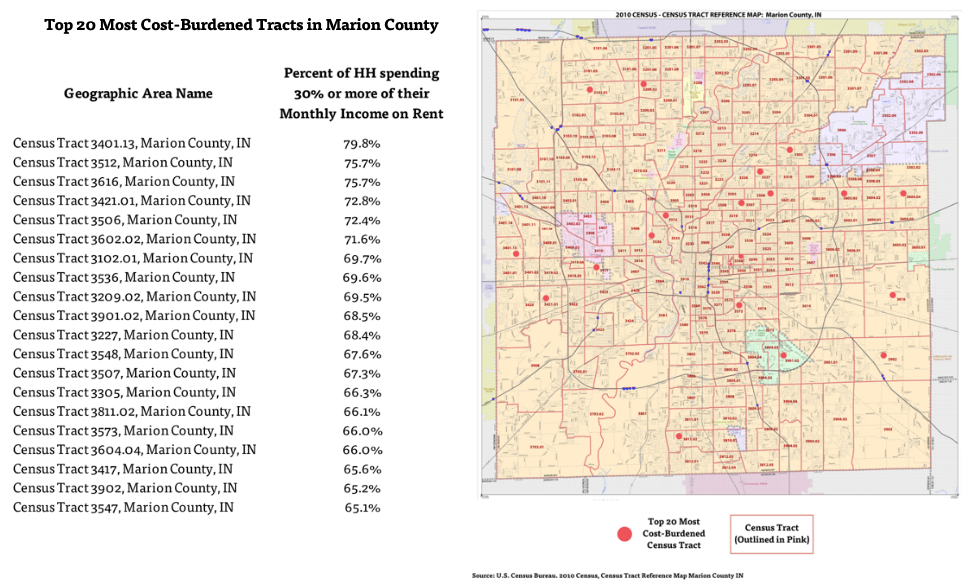
By Andrew Bradley, Jessica Fraser, and Michaela Wischmeier
With nearly maxed-out rental assistance programs, Indiana is running out of time to prevent a tsunami of evictions starting August 1, even as COVID-19 resurges through the state. Self-inflicted funding limits and a lack of statewide coordination between state and city rent assistance programs have set Indiana further back on the timeline needed to advance to higher stages of housing stability. In response, the Hoosier Housing Needs Coalition (HHNC) proposes a yardstick to measure the steps necessary to ensure COVID-19 housing stability.
On July 13, the State of Indiana and City of Indianapolis opened their COVID-19 emergency rental assistance programs after weeks of planning. In a little over a week, the state program had received 17,491 applications[1] for a program expected to serve 12,000 households, and the city suspended applications after maxing out the projected capacity of 10,000 households in the first 48 hours. Including the households covered by these two programs, the HHNC estimates that no more than 50,000 households are likely to receive some form of rental assistance from the resources available from various government, faith-based and philanthropic organizations across the state at current capacity.
As a result, over 200,000 Hoosier renter households – of the estimated 258,782 who will need rental assistance before September – will remain subject to eviction and potential homelessness, if Governor Holcomb’s eviction pause expires on July 31 as planned. With Indiana’s early attempts at rent assistance nearly maxed out, thousands of Hoosier renters are at risk of spreading disease and experiencing economic calamity from losing their housing.
To prevent evictions that will cause Indiana to regress in its COVID-19 Back On Track Plan, the Hoosier Housing Needs Coalition has developed a ‘yardstick’ to measure four necessary steps for the state to take before Gov. Holcomb should consider lifting the eviction moratorium. The necessary steps include:
1.) Coordinate rent assistance programs to align all available funding streams. This includes stacking state and local funds and incentivizing philanthropic and private participation.
2.) Ensure equitable access to rental assistance program resources. Target outreach to highest cost burden areas and racial communities most impacted by public health, income and job loss, and housing instability.
3.) Appoint an Indiana Housing Security Task Force to advise on funding, outreach, and outcomes with expertise of landlords, impacted renters, public health and housing experts.
4.) Congress should provide adequate support for #RentReliefNow, with Indiana’s Congressional delegation as champions
The ‘yardstick’ is as follows:
1.) Coordinate rent assistance programs. The current Indiana COVID-19 Rental Assistance Program provides up to $500 a month for up to four months, but families receiving rent assistance from another program are not eligible to apply. This design disincentives cities and private or philanthropic partners considering creating rent assistance programs of their own, as well as prevents ‘stacking’ local and state.
The current state program uses $25M in Coronavirus Relief Funds (of $2.4B) and $7.6M in Emergency Solutions Grant funds (of nearly $32M) allocated to the state from the CARES Act. But it leaves over $38M in Community Development Block Grants allocated to the state on the table, using none for rent assistance despite explicit authorization from HUD. funds together to help make families whole on their housing costs to avoid eviction.
Before the moratorium is lifted: Statewide coordination is needed to align available funding. The state also has not taken HHNC’s recommendations to date to provide coordination of CARES Act resources that could be used for housing stability across the state and local levels. Over a dozen Indiana cities have committed to using CARES Act resources for rent assistance, but the state has created an ‘either/or’ instead of a ‘both/and’ structure. Worse yet, while the U.S. Treasury explicitly allows CRF funds for rent assistance – and both the state and City of Indianapolis used CRF funds to launch their respective rent assistance programs, the state currently does not include rent assistance on the listof reimbursable CRF expenses for local units of government receiving CRF allocations from the state.
2.) Ensure equitable access to rental assistance program resources. Indiana must ensure that the hardest-hit communities and Hoosiers have been given equitable access to available rent assistance, including through targeted outreach. The HHNC has found that rent assistance is Indiana’s top unmet need even during the eviction moratorium, and that low-income renters and Black and Latino Hoosiers have been most impacted by COVID-19 income loss and housing instability. And while the state has relied on others for outreach, and Indy included community partners for its program that lasted three days, a coordinated statewide program must include metrics to ensure assistance is properly targeted to low-income renters and Hoosiers of color.

Before the moratorium is lifted: Rent assistance must reach the top cost-burdened Hoosiers and where Black and Latino households live.
Across Indiana, 40.4% of white renter households are cost-burdened by housing, meaning they “pay more than 30 percent of their income for housing” and “may have difficulty affording necessities such as food, clothing, transportation, and medical care.”[2] However, 44.5% of Indiana’s Latino households and 51.4% of Black households are cost-burdened.[3] In addition to Marion County, the counties with the highest rates of cost-burdened people of color include Delaware, Vigo, Johnson, Tippecanoe, Brown, Monroe, Allen, Lake, Clark, and Hendricks. For Indiana’s COVID-19 housing stability policy response to be a success, assistance must proportionally reach the most cost-burdened renters and the Black and Latino communities most impacted by the pandemic.
To assist with targeting outreach for Indiana and Marion County’s rent assistance programs, the Hoosier Housing Needs Coalition has used Census data to identify top housing cost-burdened Census tracts and areas with high proportions of Black and Latino households in the state. A larger database of these Census tracts can be found here.

While Indiana has housing cost burden across the entire state, Census data shows that the top 20 most cost-burdened communities in the state [excluding Marion County] have over two-thirds of their population allocating more than 30% of their income for rent each month. At 81%, Delaware County has the most cost-burdened census tract in the state. Geographically, these census tracts are spread across all parts of the state and include rural, suburban, and urban areas.
High proportions of Black households live in cost-burdened census tracts in many Indiana counties, including Lake, Marion, St. Joseph, Delaware, LaPorte, and Allen. In addition, large percentages of Latino households also live in cost-burdened Census tracts in many Indiana counties, including Lake, Noble, St. Joseph, Marion, Clinton, and Elkhart.

Similar to statewide trends, the top 20 cost-burdened census tracts in Marion County all have cost-burden rates of 65% or higher. Marion County has higher rates of racial diversity in its most cost-burdened census tracts, in comparison to the state as a whole. The majority of Marion County’s 20 most cost-burdened tracts have a Black population of 25% or higher, and slightly fewer than half have a Latino population above 10%.
3.) Appoint an Indiana Housing Security Task Force to advise on funding, outreach, and outcomes with expertise of landlords, impacted renters, public health and housing experts. Indiana’s ability to coordinate resources across funding sources could be significantly improved through a task force that includes elected officials, housing advocates, people of color and other Hoosiers most impacted by COVID-19 housing instability. While a COVID-19 task force already exists, the ‘Economic Relief and Recovery Team’ – appointed by the governor to plan, administer and account for federal relief funds the state of Indiana receives from the CARES Act – does not reflect this level of diversity and has not made housing stability a priority.
Before the eviction moratorium is lifted: Indiana should take up the HHNC’s recommendation for Governor Holcomb to create an Indiana Housing Stability Task Force
to represent renters, housing providers and investors, and experts in the connections between housing and public health in the decisions about Indiana’s COVID-19 housing policy response. This task force would help ensure that the hardest-hit communities are served as outlined above. Ideally, a representative of the Housing Stability Task Force would serve on the Economic Relief and Recovery Team on any housing-related decisions from this point forward.
4.) Congress should provide adequate support for #RentReliefNow, with Indiana’s Congressional delegation as champions. Indiana and Indianapolis have made progress in constructing pipelines for emergency rental assistance. And while each program could be expanded somewhat with existing CARES Act resources, the combined capacity is nowhere near the existing need for over a quarter of a million Hoosier households.
Before the eviction moratorium is lifted: Resources significant enough to provide the rent assistance needed for all ‘severely cost burdened’ (paying over 50% on housing) Hoosier renters to ensure housing stability must be appropriated. Congress must come through with #RentReliefNow, and Indiana’s Congressional delegation should be out front as champions for the hundreds of thousands of Hoosiers relying on them. We urge Indiana’s Senators and Representatives to join HHNC to support $100 billion in emergency rental assistance to help low-income renters avoid evictions and homelessness; a national, uniform moratorium on evictions; $11.5 billion to help local communities address the pressing health and safety needs of people experiencing homelessness; and at least $13 billion in additional funding for HUD and USDA housing programs to ensure housing stability during and after the pandemic, including funds for 100,000 new Housing Choice Vouchers.
“With such limited resources in Indiana’s rental assistance programs, it is incumbent upon the State and the cities that are running these programs to target their outreach efforts in the most impacted communities,” said Indiana Institute for Working Families Director Jessica Fraser. “Otherwise, these programs run the risk of widening disparity and not solving it.”
Jessica Love, Executive Director of Prosperity Indiana, said, “The last thing Indiana needs is for Hoosier families to be evicted and thrown out on the street or couch-surfing during a resurgent pandemic and exacerbating the surge we’re already seeing in COVID-19 cases. We can no longer afford to delay the policy decision to have a COVID-19 Housing Stability Plan in place.”
Andrew Bradley is Policy Director and Michaela Wischmeier is AmeriCorps Member-Fellow for Prosperity Indiana. Jessica Fraser is Director of the Indiana Institute for Working Families.
[1] Indiana has received 17,491 applications to its COVID-19 Rental Assistance Program as of July 21 according to IHCDA.
[2] Definition of cost burdened renter from https://www.huduser.gov/portal/pdredge/pdr_edge_featd_article_092214.html
[3] Source: authors’ calculations of ACS 1-Year Estimates - Public Use Microdata Sample 2018 https://data.census.gov/mdat
###
About the Hoosier Housing Needs Coalition:
Hoosier Housing Needs Coalition (HHNC) was formed by members of Indiana’s housing security advocacy community in April 2020 to support advocacy and education related to housing and homelessness prevention in response to the COVID-19 pandemic. Staffed by Prosperity Indiana through advocacy and coalition building grants from the National Low Income Housing Coalition and the Central Indiana Community Foundation, HHNC convenes partners from across Indiana to advocate for immediate, medium- and long-term housing stability policy solutions and conduct education and research to achieve federal, state, and local policies for an equitable response and recovery to the pandemic and beyond.
The HHNC Steering Committee is comprised of members from AARP Indiana, the Coalition for Homelessness Intervention & Prevention (CHIP), Fair Housing Center of Central Indiana, Family Promise of Greater Indianapolis, Indiana Coalition Against Domestic Violence, Indiana Institute for Working Families – INCAA, Prosperity Indiana, and The Ross Foundation.